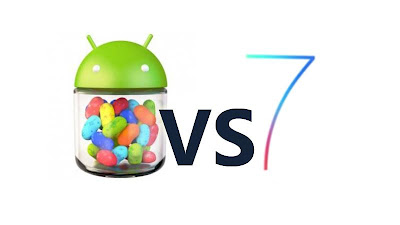On the WWDC 2013,
Apple officially released iOS 7, and declared it to come with “Biggest Change Since the Original iPhone”.
By checking what’s new in iOS 7, we could easily get the right point of iOS 7,
like the multitasking preview, Control Center, AireDrop, etc. These changes are
more cosmetic and iterative than they are groundbreaking. That's completely
understandable; not every update can spark a revolution.
However, apart from a few notable innovations, iOS 7 doesn't
seem like it's enough to overturn criticism that its growth has stalled, that
it's less innovative than archrival Android, and that it borrows heavily from
other competitors (in truth, they all steal ideas from each other). At least
not at this point in the game.
Below, you'll find a list of the iOS 7 features that Apple
focused on today, and next to that, a brief description of how that trait
exists on Android, Windows Phone, and BlackBerry
rivals (or at least one manufacturer's take on said platform). Read on below
for more detail about how iOS 7 stacks up.
| iOS 7 | Android 4.2 | Win Pho 8 | BlackBerry 10 |
|---|---|---|---|
Control Center
|
Yes, varies by phone-maker
|
No, settings
menu
|
System access settings
|
Notification center
|
Detailed notifications
|
Live tile
badges
|
BlackBerry Hub, badges
|
Multitasking preview
|
Recents list
|
Multitasking preview
|
Active Frames grid
|
Surfaced camera modes
|
Varies by Android skin
|
Third-party
lenses
|
Video, Time Shift modes
|
Photos grouped by
years, location
|
Albums, other filters
|
Albums, date
|
Albums, recent
|
Shared photo stream
|
Samsung Galaxy S4
|
Share one by one
|
Share one by one
|
Peer-to-peer sharing (AirDrop)
|
Android Beam (NFC)
|
Tap + Share (NFC)
|
NFC sharing
|
Unified browser bar
|
Yes
|
Yes
|
Yes
|
Personalized radio/discovery
|
Nokia Music
|
Third-party app
| |
Voice access to
system settings
|
Samsung's S Voice
|
No systems access
|
No systems access
|
Automatic app updates
|
Optional, by app
|
'Update all' option
|
Individual
|
Password-protected
reset
|
No
|
No
|
No
|
In-dash integration
(iOS for cars)
|
Driving mode/S Drive
|
Nokia Drive
|
Third-party apps
|
Actually, there's a lot in iOS 7 that we've seen before in
other mobile platforms, in similar if not identical forms. There's absolutely
nothing wrong with that so long as Apple executes well and brings value to the
user. The difference is that Apple's most advertised iOS 7 software additions
either play catch-up or are relatively minor, like a way to filter apps for
kids or surface camera settings in the app's top layer.
Apple does push the industry forward with some capabilities
that are all its own -- like iOS 7 for
cars and using Siri to toggle system
settings. (Samsung's S Voice does the latter, but not Android Voice
Actions.) Even with driving modes for individual handsets, such deep car
integration will be tough for the others to beat and even match without strong
automotive partnerships.
iTunes Radio may
not be a new concept, but I like that it's free for everyone, and integrated
into a native app that people already use. Google
Play Music All Access does about the same, but costs $10 per month, and
Nokia Music is free, but only on Nokia's Windows phones.
Once again, Apple's advantage is that iOS 7 will be unified
across most Apple smartphones and tablets, unlike Android, which varies greatly
by phone-maker and has a notorious track record for timely updates across
devices. Even Windows Phone has two flavors; that profits Nokia, the originator
of most extra features, but also makes Windows Phone's benefits uneven across
the entire portfolio.
Apple may not have bowled us over with headline
enhancements, but iOS 7 will continue to formidably challenge Google,
Microsoft, and BlackBerry with its eye-catching visual design and its total
haul of features, new and old. Like many things worth admiring, iOS 7 is
greater than the sum of its parts.

No comments:
Post a Comment